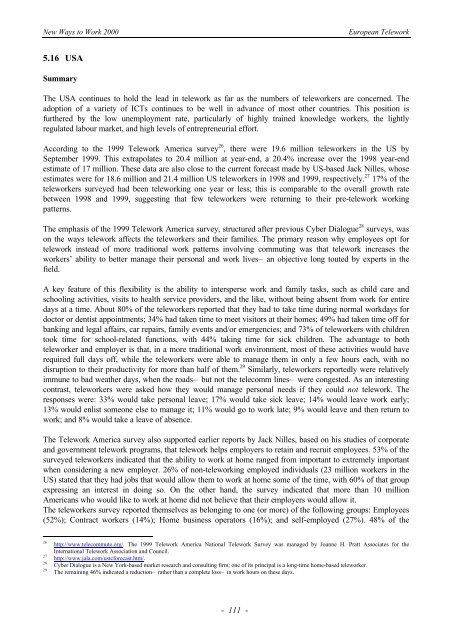eWORK 2000 - European Telework Week
eWORK 2000 - European Telework Week
eWORK 2000 - European Telework Week
- No tags were found...
Create successful ePaper yourself
Turn your PDF publications into a flip-book with our unique Google optimized e-Paper software.
New Ways to Work <strong>2000</strong><strong>European</strong> <strong>Telework</strong>5.16 USASummaryThe USA continues to hold the lead in telework as far as the numbers of teleworkers are concerned. Theadoption of a variety of ICTs continues to be well in advance of most other countries. This position isfurthered by the low unemployment rate, particularly of highly trained knowledge workers, the lightlyregulated labour market, and high levels of entrepreneurial effort.According to the 1999 <strong>Telework</strong> America survey 26 , there were 19.6 million teleworkers in the US bySeptember 1999. This extrapolates to 20.4 million at year-end, a 20.4% increase over the 1998 year-endestimate of 17 million. These data are also close to the current forecast made by US-based Jack Nilles, whoseestimates were for 18.6 million and 21.4 million US teleworkers in 1998 and 1999, respectively. 27 17% of theteleworkers surveyed had been teleworking one year or less; this is comparable to the overall growth ratebetween 1998 and 1999, suggesting that few teleworkers were returning to their pre-telework workingpatterns.The emphasis of the 1999 <strong>Telework</strong> America survey, structured after previous Cyber Dialogue 28 surveys, wason the ways telework affects the teleworkers and their families. The primary reason why employees opt fortelework instead of more traditional work patterns involving commuting was that telework increases theworkers’ ability to better manage their personal and work lives— an objective long touted by experts in thefield.A key feature of this flexibility is the ability to intersperse work and family tasks, such as child care andschooling activities, visits to health service providers, and the like, without being absent from work for entiredays at a time. About 80% of the teleworkers reported that they had to take time during normal workdays fordoctor or dentist appointments; 34% had taken time to meet visitors at their homes; 49% had taken time off forbanking and legal affairs, car repairs, family events and/or emergencies; and 73% of teleworkers with childrentook time for school-related functions, with 44% taking time for sick children. The advantage to bothteleworker and employer is that, in a more traditional work environment, most of these activities would haverequired full days off, while the teleworkers were able to manage them in only a few hours each, with nodisruption to their productivity for more than half of them. 29 Similarly, teleworkers reportedly were relativelyimmune to bad weather days, when the roads— but not the telecomm lines— were congested. As an interestingcontrast, teleworkers were asked how they would manage personal needs if they could not telework. Theresponses were: 33% would take personal leave; 17% would take sick leave; 14% would leave work early;13% would enlist someone else to manage it; 11% would go to work late; 9% would leave and then return towork; and 8% would take a leave of absence.The <strong>Telework</strong> America survey also supported earlier reports by Jack Nilles, based on his studies of corporateand government telework programs, that telework helps employers to retain and recruit employees. 53% of thesurveyed teleworkers indicated that the ability to work at home ranged from important to extremely importantwhen considering a new employer. 26% of non-teleworking employed individuals (23 million workers in theUS) stated that they had jobs that would allow them to work at home some of the time, with 60% of that groupexpressing an interest in doing so. On the other hand, the survey indicated that more than 10 millionAmericans who would like to work at home did not believe that their employers would allow it.The teleworkers survey reported themselves as belonging to one (or more) of the following groups: Employees(52%); Contract workers (14%); Home business operators (16%); and self-employed (27%). 48% of the26272829http://www.telecommute.org/. The 1999 <strong>Telework</strong> America National <strong>Telework</strong> Survey was managed by Joanne H. Pratt Associates for theInternational <strong>Telework</strong> Association and Council.http://www.jala.com/ustcforecast.htm/.Cyber Dialogue is a New York-based market research and consulting firm; one of its principal is a long-time home-based teleworker.The remaining 46% indicated a reduction— rather than a complete loss— in work hours on these days.- 111 -








